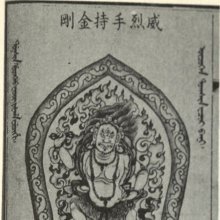Candavajrapani, Caṇḍavajrapāṇi, Canda-vajrapani: 3 definitions
Introduction:
Candavajrapani means something in Buddhism, Pali, Hinduism, Sanskrit. If you want to know the exact meaning, history, etymology or English translation of this term then check out the descriptions on this page. Add your comment or reference to a book if you want to contribute to this summary article.
Alternative spellings of this word include Chandavajrapani.
Images (photo gallery)
In Buddhism
Tibetan Buddhism (Vajrayana or tantric Buddhism)
Source: OSU Press: Cakrasamvara SamadhiCaṇḍavajrapāṇi (चण्डवज्रपाणि) refers to the “fierce Vajrapāṇi”, according to the Guru Mandala Worship (maṇḍalārcana) ritual often performed in combination with the Cakrasaṃvara Samādhi, which refers to the primary pūjā and sādhanā practice of Newah Mahāyāna-Vajrayāna Buddhists in Nepal.—Accordingly, “Oṃ homage to the fierce Vajrapāṇi [e.g., caṇḍavajrapāṇi], great vajra-anger, a Bhairava, With gigantic fangs, grasping in hand a sword, club, ax and noose”.

Tibetan Buddhism includes schools such as Nyingma, Kadampa, Kagyu and Gelug. Their primary canon of literature is divided in two broad categories: The Kangyur, which consists of Buddha’s words, and the Tengyur, which includes commentaries from various sources. Esotericism and tantra techniques (vajrayāna) are collected indepently.
Mahayana (major branch of Buddhism)
Source: De Gruyter: A Buddhist Ritual Manual on AgricultureCaṇḍavajrapāṇi (चण्डवज्रपाणि) refers to the “leader of Yakṣas” [i.e., namaścaṇḍavajrapāṇaye mahāyakṣasenāpataye], [as mentioned in the Vajra-beak dhāraṇī taught by the Garuḍa-king], according to the Vajratuṇḍasamayakalparāja, an ancient Buddhist ritual manual on agriculture from the 5th-century (or earlier), containing various instructions for the Sangha to provide agriculture-related services to laypeople including rain-making, weather control and crop protection.

Mahayana (महायान, mahāyāna) is a major branch of Buddhism focusing on the path of a Bodhisattva (spiritual aspirants/ enlightened beings). Extant literature is vast and primarely composed in the Sanskrit language. There are many sūtras of which some of the earliest are the various Prajñāpāramitā sūtras.
Languages of India and abroad
Sanskrit dictionary
Source: Cologne Digital Sanskrit Dictionaries: Edgerton Buddhist Hybrid Sanskrit DictionaryCaṇḍavajrapāṇi (चण्डवज्रपाणि).—the fierce V., a form of Vajrapāṇi, with epithet mahāyakṣasenāpati: Śatasāhasrikā-prajñāpāramitā 2.2.
Sanskrit, also spelled संस्कृतम् (saṃskṛtam), is an ancient language of India commonly seen as the grandmother of the Indo-European language family (even English!). Closely allied with Prakrit and Pali, Sanskrit is more exhaustive in both grammar and terms and has the most extensive collection of literature in the world, greatly surpassing its sister-languages Greek and Latin.
See also (Relevant definitions)
Relevant text
No search results for Candavajrapani, Caṇḍavajrapāṇi, Canda-vajrapani, Caṇḍa-vajrapāṇi; (plurals include: Candavajrapanis, Caṇḍavajrapāṇis, vajrapanis, vajrapāṇis) in any book or story.
Related products
